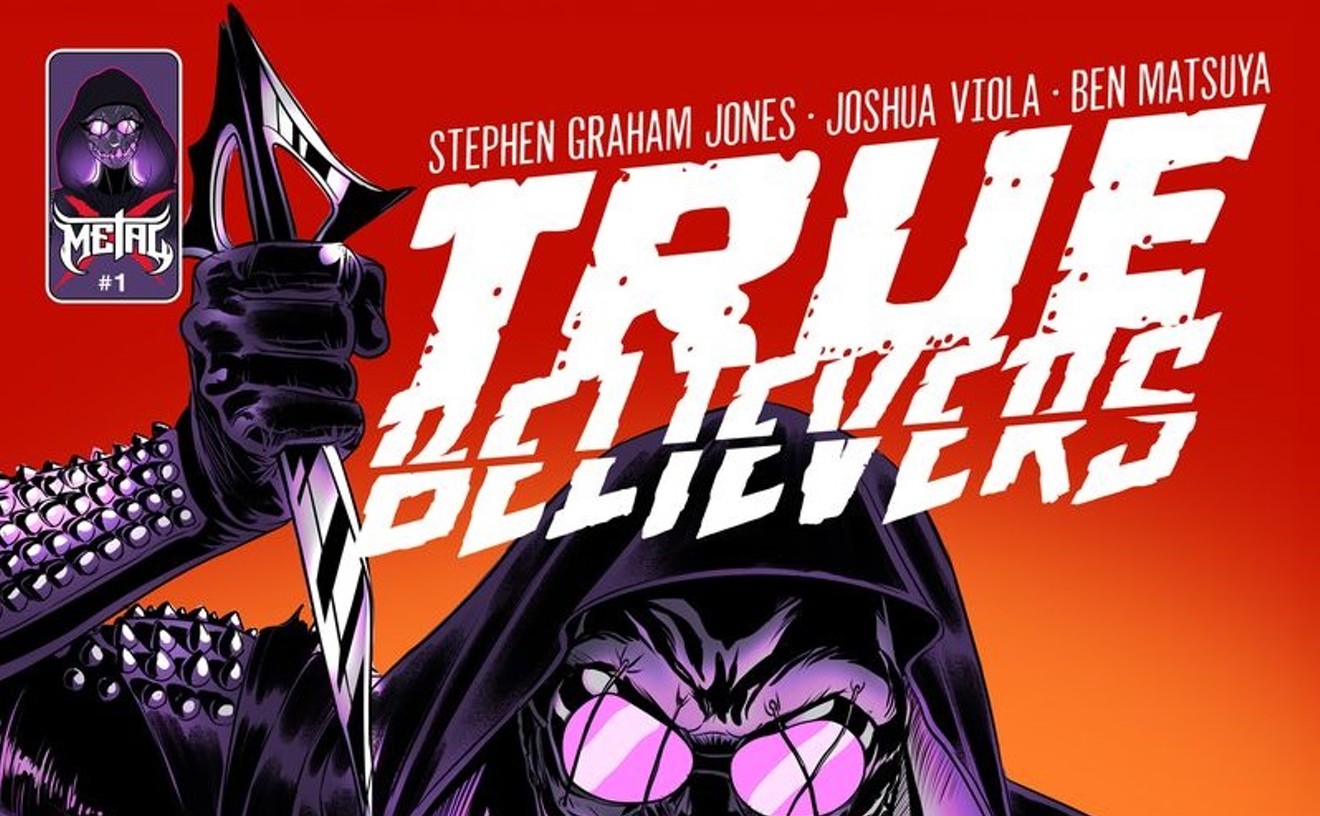See also: - Castles in the Sky: Miyazaki, Takahata and the-Masters of Studio Ghibli - Ponyo - The Wiz
Intrigued? Then thank the Denver Film Society for its fall film series "Castles in the Sky: Miyazaki, Takahata and the Masters of Studio Ghibli," which kicks off tonight at the Denver FilmCenter with an array of films in brand-new 35mm prints on the big screen and continues with changing programs through mid-October.
The Academy Award-winning Spirited Away is considered Miyazaki's masterpiece, so it's a good place to start -- and always worth seeing again. And you can -- what follows is a sneak peek at some our other favorites in the series. For a complete schedule, visit the DFS online.
Nausicaä of the Valley of the Wind, Hayao Miyazaki, 1984Nausicaä, Miyazaki's first feature-length film, is an epic tale and the first of many stories revolving around a resolute young female protagonist. Inthis case, she's a princess caught in a future world overrun by noxious gases and a fearful but misunderstood herd of giant caterpillar-like creatures called the Ohmu. It's a film of great beauty, and the recurring idea of human flight -- in this case, on gliders -- also makes an early appearance.
Castle in the Sky, Hayao Miyazaki, 1986
Miyazaki's first film under the Studio Ghibli banner, Castle features a boy and a girl with magical powers and comic relief via an airborne pirate queen named Dola and her protective pack of pirate sons, all marooned on Laputa, the last of a network of floating cities in the sky brought to ruin. The girl, Sheeta, possesses a powerful crystal amulet that comes in handy as she and the boy, Pazu, discover the secrets of the long-abandoned city; Dola stands as one of many magical and sometimes dangerous grannies who people Miyazaki's worlds.
Our Studio Ghibli guide continues on the next page
My Neighbor Totoro, Hayao Miyazaki, 1988
Totoro is a kids' movie through and through, but like most of Miyazaki's work, it's shot through with dark undertones. When two adorable yet self-reliant little girls, Satsuki and her baby sister Mei, move with their father to a rural area, they discover a family of Totoros -- round, smiling, forest cheshire-creatures with rabbit ears -- who take them on fantastic adventures. In the film, only the girls can see the creatures; some interpret that to mean they are visible only to children. But some opinions run darker -- others think the Totoros can only be seen by those who are close to death. Regardless of which camp you end up believing, it's a nonessential distinction in the face of this beautiful and often whimsical vehicle. A must-see for anyone interested in understanding the Miyazaki mystique.
Kiki's Delivery Service, Hayao Miyazaki, 1989
Based on the engaging children's book by Eiko Kadono, Kiki, like most of Miyazaki's adaptations, really takes off on its own tangents. But the basic characters -- the endearingly positive witch girl Kiki and her sidekick Jiji, a talking black cat -- remain true to the original plot. The story follows the unstoppable Kiki as she builds herself a career as a delivery girl on a broomstick and overcomes daunting odds; again, Miyazaki takes viewers on a beautiful ride through the vagaries of life.
Our Studio Ghibli guide continues on the next page
Porco Rosso, Hayao Miyazaki, 1992
In Porco Rosso, Miyazaki's great love for the history of aviation bears fruit: His hero is a disenfranchised war pilot turned bounty hunter (and, supernaturally, into a literal pighead) plotted into the historical milieu of Fascist-era Italy. There he teams up with the forthright, red-headed teen aircraft mechanic and designer Fio, granddaughter of his old friend Piccolo; together, Porco and Fio overcome a variety of often-humorous enemies while on the road to finally turning the pig back into a man. The depictions of airplanes and flight in Porco Rosso are inspiring; once again, Miyazaki touches his audience's soul with a feeling of exhilaration and optimism.
Pom Poko, Isao Takahata, 1994
This fable, created by Miyazaki's Studio Ghibli partner Isao Takahata, takes off on a Miyazakian nature-versus-civilization tangent dealing with the tanuki, an endangered race of folkloric (and funny) raccoon people whose lifestyle is threatened by an encroaching suburb. In reaction, the tanuki cook up some mischief, creating a spirit parade that makes for one of the strangest sequences of animation you'll ever see; it's one of those things you just have to eyeball for yourself.
Our Studio Ghibli guide continues on the next page
Whisper of the Heart, Yoshifumi Kondō, 1995
Created for Studio Ghibli by Yoshifumi Kondō, Whisper of the Heart follows Ghibli form in some ways, but also travels in its own lovely dimension, weaving a story about young love and finding one's path in the world. Music-lovers will especially enjoy this sweet slice, which includes an earnest, Japanified version of "Take Me Home, Country Roads."
Princess Mononoke, Hayao Miyazaki, 1997
Miyazaki's obsession with the yin/yang of the human and spirit worlds reaches a pinnacle in the visually splendid Princess Mononoke, which fiercely harks back to the Samurai warriors of old. The princess, raised by wolves (something you won't doubt for a moment), meets the warrior Ashitaka, making for an edgy and unlikely relationship and, in the end, each retires to their respective worlds.
Our Studio Ghibli guide continues on the next page
Spirited Away, Hayao Miyazaki, 2001
Spirited Away is the Studio Ghibli standbearer, a richly visual encapsulation of all of Miyazaki grand themes that begins innocently when the young girl Chihiro happens upon an abandoned amusement park with her parents. The story quickly turns dreamlike and often scary; Chihiro, renamed Sen, finds herself working in a bathhouse, where she encounters a variety of spirits, a young man named Haku who transforms into a dragon, a cruel taskmistress Yubaba and others. Her story eventually brings her her back to where she started. This one will stick with you.
Howl's Moving Castle, Hayao Miyazaki, 2004
A very loose interpretation of the novel by Diana Wynne Jones, Howl's Moving Castle is the tale of a young girl, Sophie, who is turned into a crone by a witch's curse. Sophie becomes housekeeper to the mysterious wizard Howl; the story moves from scene to scene as if from dream to dream, like a twisted Wizard of Oz story trapped in a traveling steampunk contraption of a castle that's also home to a talking ball of fire named Calcifer. Some were disappointed with this follow-up to Spirited Away, but once you accustom yourself to its quirky rhythms, it all begins to make sense.
Our Studio Ghibli guide continues on the next page Ponyo, Hayao Miyazaki, 2008
Ponyo, yet another kid-oriented Miyazaki confection built upon the shred of another story, has a vague Little Mermaid theme but a personality all its own. Miyazaki's been called the Disney of Japanese animation, but that's not quite right; Ponyo shows why. Awash in the same kind beautiful, fluid color and visuals you'd expect from classic Disney, it's the story that takes a left turn. Miyizaki's creative vision takes you to a completely different, more primeval and unjudgmental place.
Find information on hundreds of other arts and entertainment events in our online Calendar.
To keep up with the Froyd's eye-view of arts and culture in Denver, "like" my fan page on Facebook.
Follow @WestwordCulture











